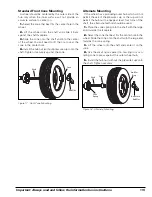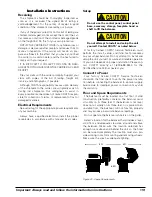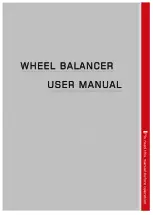
Important: Always read and follow the information box instructions.
• 17
Machine Calibration
Calibration
1.
Mount a 14, 15, or 16-inch steel tire/wheel assem-
bly on the balancer. A balanced tire/wheel is required.
Note:
Position wheel so that no weights on either
flange are at the top-dead-center location. Turn the
machine OFF then ON.
2.
Enter DIMS (A, W, and D wheel dimensions).
3.
Press and hold the SHIFT key and press 1 to select
the CAL MACHINE mode.
4.
Lower the hood and press START.
5.
After spin, raise the hood. Rotate wheel until the
right plane center bar blinks; attach test weight to the
outside flange at top-dead-center: 4-ounce (100 grams)
Figure 19 - Test Weight On Outside Flange At Top-Dead-Center
6.
Lower the hood and press START.
Important:
It is critical that the inner weight be
placed accurately to achieve proper calibration. If the
test weight is not moved from the outside flange
directly across to the inside flange an inner weight
placement error will occur. To correct, follow the infor-
mation box instructions.
7.
After spin, raise the hood. Rotate wheel until the
left plane center bar blinks; move and attach test
weight to the inside flange at top-dead-center: 4-ounce
(100 grams)
Figure 20 - Test Weight Moved (Directly Across) To Inside
Flange
8.
Lower the hood and press START.
9.
Calibration complete. Press NEXT.
Maintenance Instructions
The balancer requires only minor maintenance to
keep the unit operating properly.
1.
Keep the display clean and clear. Use a damp
cloth. Do not use cleaners or solvents which leave oily
or filmy residues behind.
2.
Keep the adapters, cones, faceplate, threaded
shaft, pressure cup, and hub nut clean. Grease and dirt
buildup will cause inaccurate balancing and premature
wear. Clean these items at least once a day with a
vaporizing solvent.
3.
Clean weight tray and any accessory posts, pegs,
or storage shelves with a vaporizing solvent. Weights
stored in a dirty tray may pick up grease and dirt which
may keep them from securely attaching to the wheel.
Use common sense, this is an electrical
device. Exposing the balancer to water,
either by hose or bucket, or by exposure to
rain or snow, may cause risk of shock or
electrocution to operator or bystanders.
Place, store, and operate the balancer only
in a dry, sheltered location.
Do not hose down with water or bucket
wash the balancer. Extensive damage to the
balancer will result. Sensitive electronic
components, wiring harnesses, and other
devices housed in the balancer are not
intended to be exposed to water.
4.
Keep the area around the balancer clear. Remove
any tools or other items that are leaning against the
balancer. Keep the area under the balancer clear.
Remove any items that may cause the balancer to not
sit level. Be particularly cautious of new or used wheel
weights on the floor, as they may cause personal injury
due to falls.
5.
To replace Arm Laser battery, remove cap. Discard
old batteries. Install two new batteries, plus side up.
Replace cap.
CAUTION
WARNING
Arm
Laser
Case
Cap
Arm Laser
Batteries
A&D Arm























